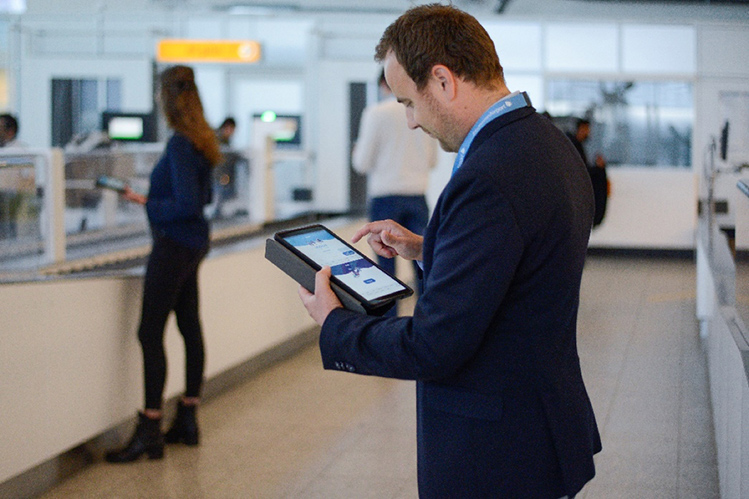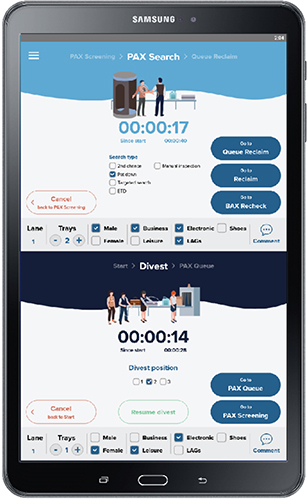Point FWD has been developing and using its Security Checkpoint Insight Tool for over five years in its consultancy work for clients worldwide. It is now sharing this approach, in the form of an Android application, with airports, OEMs and security operators, enabling them to do their own process measurements.

Point FWD has been developing and using its Security Checkpoint Insight Tool for over five years in its consultancy work for clients worldwide. It is now sharing this approach, in the form of an Android application, with airports, OEMs and security operators, enabling them to do their own process measurements.
The tool has been enriched every year by incrementally adding more and more functionality. “The idea to share the tool existed quite early, mainly by noticing the key value of leveraging detailed process data as the basis for operational development,” explains Robin van Gemert, Senior Consultant, Point FWD. “In November last year we got the feeling we gained the right level of maturity to have stakeholders perform these measurements on their own, thereby providing increased accessibility for gaining insights, and to start changing easily. On top of that, now that airports need to cope with changing measures related to COVID-19, this tool can be helpful for security process monitoring and understanding the new baseline, as well as performing an impact analysis of imposed measures.”
Capturing data at a passenger level

The core value of the Checkpoint Insight Tool is to establish a baseline performance overview, facilitating effective, measurable and successful change in security checkpoints.
The core value of the Checkpoint Insight Tool is to establish a baseline performance overview, facilitating effective, measurable and successful change in security checkpoints. It is designed to help airports gain detailed insight into security bottlenecks, showing how to change to maximise process capacity. “The airport or security operator mainly obtain benefits in terms of efficiency and cost-effectiveness, whereas the passenger could really experience security in a different manner by improving and expediting the journey,” says van Gemert.
The data captured is at a passenger level – the Checkpoint Insight Tool follows a passenger from the start to end of their security journey – meaning it has a great level of detail, making it possible to leverage the data in a versatility of challenges.
“For example, by recording the contents that passengers carry – such as LAGs and electronics in the case of EDS CB projects – and by assessing the specific process times in the case of certain content types, the impact of EDS CB scenarios can be outlined for a specific airport situation,” van Gemert explains. “Doing so, airports could undertake procurement mainly based on their requirements and passenger profile, managing to achieve fit-for-purpose equipment selection. It all starts by having key insight in your baseline situation. Then, the impact of every change – legislative, equipment specific or ConOps wise – can be assessed in detail.”
The tool accommodates all regulated and commonly deployed security equipment components around the world. It furthermore provides the flexibility to configure airport-specific configurations, including secondary means of screening and alarm resolution procedures. Since equipment might differ within a single checkpoint, multiple security lane configurations over several collection devices can be used for that specific checkpoint.
As opposed to how Point FWD collected data previously, clients should now be able to collect more security process data in less time. Hence, one of the major benefits is a cost-efficient and scalable way of collecting highly detailed and valuable data.
Baseline performance output reports

The Checkpoint Insight Tool follows a passenger from the start to end of their security journey – meaning it has a great level of detail, making it possible to leverage the data in a versatility of challenges.
One of the goals of Point FWD is to make security checkpoint change more accessible. Intuitive data collection is key in achieving this. “We do provide end-user training to ensure an understanding of the functionality, flexibility in checkpoint and lane configurations, and how to manage exceptional situations,” says van Gemert. “This becomes increasingly important when less process knowledgeable – non-security-involved staff – will be performing measurements.”
At the output analysis side, Point FWD is currently focusing on supplying standardised baseline performance output reports. In doing so, clients are quickly able to get insight in their security performance on a number of common KPIs. “Analyses on specific questions such as impact of lane modifications, equipment implementation or bottleneck analyses usually take more time, incorporating a rather consultative approach and guidance by the Point FWD team,” van Gemert comments. “But, of course, every airport that feels comfortable enough, can chase their own process goals by assessing their own data.”
Maximising security flow safely and securely post-COVID-19
Point FWD has recently been talking to several airports with which it aims to gain actual insight into their COVID-19 situation, with the help of the Checkpoint Insight Tool.
COVID-19 presents unique challenges across all airport processes, including at the security checkpoint. “Indeed, what we see is that especially touch-point intensive processes are heavily affected by common COVID-19 measures, security being one of these processes,” says van Gemert. “As passenger numbers pick up again during the post-COVID-19 transition period, current airport process capacities – for example queue areas, check-in areas – will likely be insufficient. However, whereas lots of airport stakeholders look at managing these capacities in isolation, especially queuing, we are convinced that we need to look at maximising the security flow in a safe, secure and stable manner. Where time and spacing are scarce, focus should be on accurate planning, which all starts with understanding the new baseline with imposed COVID-19 measures.”
Enquiries about the Checkpoint Insight Tool, demo requests and exploration of usage possibilities can be sent to robin@pointfwd.com

Point FWD has recently been talking to several airports with which it aims to gain actual insight into their COVID-19 situation, with the help of the Checkpoint Insight Tool.







